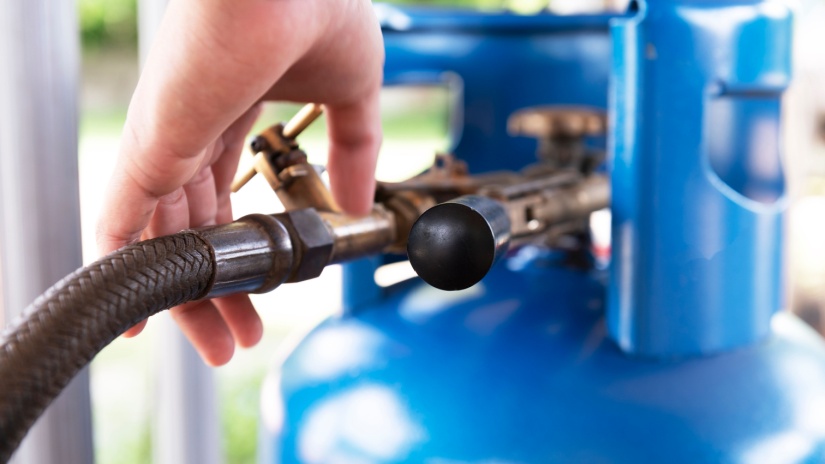Knowledge Centre
What is LPG?

In Australia, white LPG gas bottles power countless BBQs annually. But have you ever pondered the origins of LPG and how it differs from natural gas? Get all your questions about LPG answered here with Compare Energy.
What is LPG?
Liquefied petroleum gas (LPG) is a blend of propane and butane gases, derived during the refining of crude oil. After extraction from deep underground, LPG is stored under pressure to maintain its liquid state. Upon release of pressure, it converts back into a gaseous form.
LPG serves various purposes including heating, cooking, and as a fuel for vehicles. Known for its clean-burning properties, LPG is considered environmentally friendly compared to conventional fossil fuels like coal. It produces fewer carbon dioxide emissions and has lower sulphur content.
While most Australians recognise LPG from small BBQ gas bottles, it is also supplied in larger tanks or cylinders for households without piped natural gas, and for use in caravans. Industries use LPG extensively for kilns, ovens, steam boilers, and LPG-powered forklifts.
Is LPG like natural gas?
LPG differs from natural gas, which is primarily methane. However, many cooking appliances designed for natural gas can also use LPG. LPG is stored and transported under pressure in gas cylinders or tanks, similar to those used for vehicles converted to run on LPG.
In contrast, natural gas (methane) is cooled to minus 162 degrees Celsius to liquefy it, a process called liquefaction. This liquefied natural gas (LNG) occupies only 1/600th of its gaseous volume, allowing it to be transported in specialised LNG tankers that transport Australian natural gas globally.
How is LPG sourced?
LPG is obtained through the refinement of fossil fuels, primarily in two ways: It is extracted during natural gas production or produced during the refining of crude oil.
Approximately 80% of Australia's LPG is extracted during the natural gas production process, while the remaining 20% is derived from crude oil refining.
When natural gas is extracted, LPG is separated during refining as a byproduct. Despite starting as natural gas, LPG is denser and liquefies easily at higher temperatures (37.8°C) compared to natural gas (-162°C). This makes it safe and practical to transport in gas bottles for residential and commercial use.
From crude oil, LPG is extracted through a process called cracking, where heavy hydrocarbon molecules are broken down into lighter forms like LPG and gasoline. Around 3% of crude oil is refined into LPG. Both types of LPG can be used interchangeably for transport and heating in homes, businesses, and industries.
Is there a difference between LPG and natural gas?
There are several differences between LPG and natural gas worth noting. Natural gas is primarily methane (CH4), while LPG in Australia consists mainly of propane. Another distinction lies in how they are sourced and delivered.
LPG is extracted from natural gas and transported in liquid form via canisters, whereas natural gas is extracted from underground reservoirs and delivered as a gas through pipelines known as the gas mains.
Natural gas is often used for larger home systems like heating and hot water due to its connection to the gas mains. LPG, on the other hand, is more suitable for smaller appliances with specific connection points, such as BBQs and stovetops.
LPG also burns at a higher temperature than natural gas, making it more energy efficient. This means LPG requires less gas to produce the same amount of heat compared to natural gas.
Our team can talk you through your gas options if you are currently running gas in your home. We’re on 1300 790 106 and based in Australia, so give us a call to discuss gas providers and which options work for your home.
Why does LPG smell bad?
Propane and butane gases are typically odourless, so why does it have such a strong smell when BBQ gas bottles are refilled? The answer lies in a safety measure: a foul-smelling substance is added to the gas to alert people to potential leaks.
This substance, known as ethyl mercaptan (or ethanethiol, CH3CH2SH), is mixed with propane during bottling. Ethyl mercaptan is notorious for its extremely unpleasant odour, often described as similar to rotten eggs, rotten cabbage, garlic, or even the scent of a skunk. How individuals perceive this smell can vary based on their sense of smell and olfactory sensitivity.
Regardless of how it smells to you, the presence of this strong odour is a critical warning sign. Never ignore it, as gas leaks are highly flammable and can lead to dangerous explosions.
Benefits of LPG
There are plenty of benefits of using LPG and some of those include:
- It’s versatile. LPG can be used for a variety of purposes including heating, cooking, hot water systems, and even as a fuel for vehicles.
- It has a high energy efficiency. LPG burns cleanly and efficiently, providing high energy output compared to other fossil fuels.
- It produces fewer emissions. It produces fewer greenhouse gas emissions compared to coal or oil, contributing to better air quality.
- Easily stored and transported. LPG is stored and transported in liquid form under pressure, making it easy to store and transport to areas not served by natural gas pipelines.
- Instant heat. LPG appliances provide instant heat with precise control over temperature, making it convenient for cooking and heating.
- It’s cheaper than other options. LPG is often cost-effective compared to other energy sources, with competitive pricing and efficient energy usage.
- It’s reliable. It provides a reliable energy source even in areas where natural gas may not be available, ensuring consistent supply for homes and businesses.
What to do if you smell gas
Ethyl mercaptan is added to both LPG and natural gas because it is detectable by most people at very low concentrations, less than 25 parts per million.
Dogs can detect it at even lower levels. This makes it an effective early warning signal for the presence of gas in the air. If you detect the smell of gas, follow these steps:
- If you are indoors, immediately turn off all appliances, pilot lights, and any potential sources of ignition.
- Shut off the gas at its source, typically by closing the valve on the gas bottle or main supply.
- Evacuate the enclosed space promptly, ensuring everyone else leaves the area as well.
- After shutting off the gas, ventilate the area by opening all doors and windows to allow gas to disperse.
- Do not re-enter your home or caravan until the smell of gas has completely dissipated.
- If you detect the smell of gas outdoors or in the street, contact 1800 GAS LEAK (1800 427 532) to report the issue to the Australian Gas Network. The emergency operator will provide you with instructions on how to proceed safely.
Taking these actions promptly can help mitigate the risks associated with a gas leak, ensuring safety for everyone involved.
How is LPG used in Australia?
Household energy
LPG is widely used for household energy in Australia, with around two million households relying on it. Common appliances like ovens, stovetops, barbeques, heaters, and hot water systems are compatible with LPG connections.
It's favoured for its affordability and convenience, especially in rural areas where it's stored in cylinder tanks outdoors and refilled as needed.
Industrial heating and power generation
In Australia, LPG serves various industrial purposes, including heating and powering gas engines in forklifts and industrial boilers. Its high heat output and efficiency make it popular among businesses needing reliable energy.
According to Gas Energy Australia, LPG contributes over $3.5 billion annually to the national economy. Some companies also use LPG as a backup or off-grid energy source alongside renewables.
Which providers supply LPG in Australia?
In Australia, several energy providers supply LPG to homes and businesses. Here are some of the key suppliers:
Elgas
Elgas is a leading supplier of LPG across Australia, offering services to residential, commercial, and industrial customers.
Origin Energy
Origin Energy provides LPG for homes and businesses, offering flexible delivery options and customer service.
Kleenheat
Kleenheat supplies LPG to residential and commercial customers in Western Australia and the Northern Territory.
Supagas
Supagas is another major supplier of LPG across Australia, catering to residential, commercial, and industrial needs.
AGL
AGL supplies LPG to residential customers in certain areas, offering competitive pricing and reliable delivery.
Bottled Gas Supplies
Bottled Gas Supplies serves residential and commercial customers in various regions, providing LPG in cylinder tanks.
These providers offer different delivery options, pricing structures, and customer service benefits, catering to the diverse needs of LPG consumers across Australia.
Remember, there could be additional LPG suppliers serving your area, and not all of the companies listed above operate in every region across Australia. It's worthwhile to check locally to explore all available options for LPG supply.
How often does LPG need to be replaced?
When it comes to replacing your LPG cylinder, the frequency depends largely on personal factors like the size of your gas tank and how often you use it.
Different companies offer various options: some refill cylinders when it’s running low, while others replace them entirely with a new one. If you use LPG infrequently, you might prefer purchasing gas as needed.
For heavier users, providers can establish a refill schedule based on your consumption history to ensure continuous supply.
Signs your LPG has run out
Here are various methods to determine how much gas is left in your BBQ gas bottle:
Shake test
- To get a rough idea of the gas level, simply shake the bottle. If there is gas remaining, you'll hear liquid sloshing inside.
Hot water test
- Prepare a cup or kettle with hot (not boiling) water.
- Pour the hot water down the side of the gas bottle slowly, starting from the top.
- Feel the surface of the gas bottle with your hand as you pour.
- The point where the bottle starts feeling cold indicates the gas level inside.
Keep in mind, this method provides only an estimate and may not be very precise. It's advisable to keep a spare gas bottle handy to avoid running out during your BBQ.
Weighing method
- Most BBQ gas bottles have their empty weight and total weight when fully stamped on them.
- Use a set of scales to weigh the current bottle.
- Subtract the empty weight from the current weight to estimate the remaining gas.
- For example, a standard 9kg BBQ gas bottle weighs between 16.2kg and 19.8kg when full (empty weight approximately between 7.2kg and 10.8kg).
Gas level indicators
Gas level indicators are magnetic strips that stick to the side of the gas bottle, providing a visual indication of the gas level. They detect temperature differences between the gas inside and the empty cylinder. These indicators are affordable (around $2 – $5) and available online or at hardware stores.
Gas bottle gauges
Some gas bottles come with gauges that display approximate gas levels with markings like full, half, or empty. These gauges can be useful for monitoring gas levels and are typically priced between $20 and $35. It can also be fitted to an empty BBQ gas bottle before refilling.
These methods offer various ways to gauge the amount of gas remaining in your BBQ bottle, ensuring you're prepared for your next outdoor cooking session.
Is LPG cheaper?
Natural gas is generally cheaper per megajoule (MJ) than LPG. However, for households with lower gas usage, LPG can be more economical. This is because natural gas includes a daily supply charge of around 40 to 60 cents, which is payable even if no gas is used.
On the other hand, LPG delivery may involve service costs, especially if the supply is quickly depleted. For personalised advice on choosing the best gas option for your needs, visit our natural gas vs. LPG comparison page.
Should you choose LPG for your home?
If you reside in a remote or rural area without access to natural gas pipelines, LPG could be an ideal choice. However, for larger homes with high gas consumption, it's prudent to compare costs between natural gas and LPG to find the most economical option.
Always assess your gas usage before making a decision to ensure it aligns with your needs. If you're confident that LPG is the right choice for you, reach out to our Australia-based call team on 1300 790 106 for assistance.

